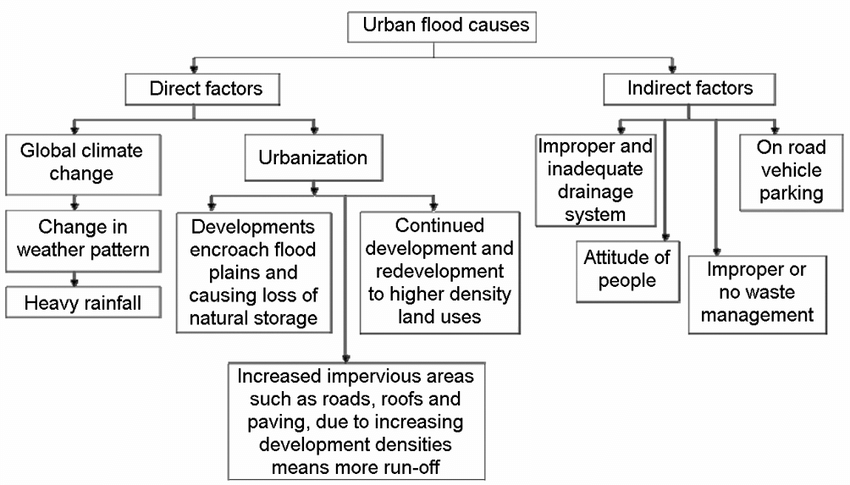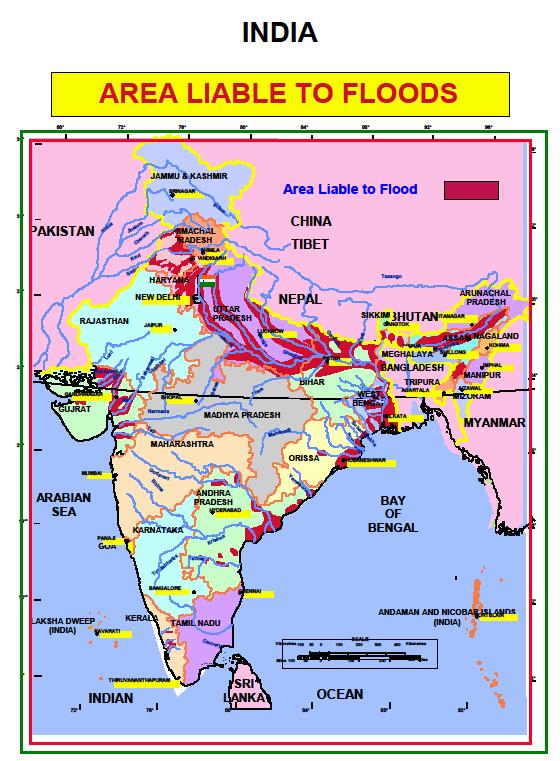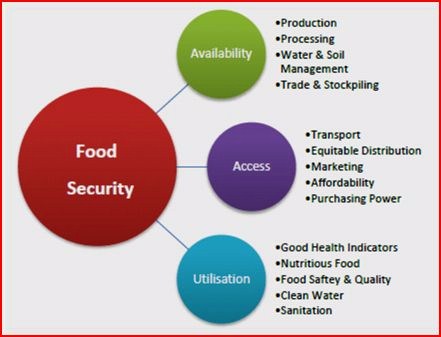Contents
- Dealing with a deluge
- The message in the peace Nobel
- The road to zero hunger by 2030
Dealing with a deluge
Context:
As floods swamp Hyderabad, the focus is on the inadequacy of drainage infrastructure
Relevance:
- GS Paper 1: Urbanization
- GS Paper 3: Disasters & Disaster Management
Mains Questions:
- The frequency of urban floods due to high intensity rainfall is increasing over the years. Discussing the reasons for urban floods. highlight the mechanisms for preparedness to reduce the risk during such events. (15 marks)
- The effects of flooding due to deluges can only be mitigated if urban planners take into account the hydro-geology of cities and ensure that construction, development and land occupation do not take place in a way that reduces the area of wetlands. Elaborate (15 marks)
1: What is disaster?
“Disaster is an undesirable occurrence resulting from forces that are largely outside human control, strikes quickly with little or no warning, which causes or threatens serious disruption of life and property including death and injury to a large number of people, and requires therefore, mobilisation of efforts in excess of that which are normally provided by statutory emergency services”.
2: What is flood?
Flood is Inundation of land and human settlements by the rise of water in the channels and its spill-over. Floods occur commonly when water in the form of surface run-off exceeds the carrying capacity of the river channels and streams and flows into the neighbouring low-lying flood plains.
3: What are the causes of flood in India?
Flood is a natural phenomena but recent times anthropogenic factors are more responsible for flood in India.
Natural causes of flood:-
- Floods can be caused due to a storm surge (in the coastal areas).
- High intensity rainfall for a considerably longer time period.
- Melting of ice and snow.
- Reduction in the infiltration rate and presence of eroded material in the water due to higher rate of soil erosion.
Anthropogenic causes of flood: Human beings play an important role in the genesis as well as spread of floods.
- Indiscriminate deforestation
- Unscientific agricultural practices.
- Disturbances along the natural drainage channels and colonisation of flood-plains and river-beds.

Causes of recent flood in Hyderabad: Construction over lake beds and encroachments of drainage channels have been identified as problems that have exacerbated flooding and inundation in the city in the past.
4: Geographical distribution of flood in India: Rashtriya Barh Ayog (National Flood Commission) identified 40 million hectares of land as flood-prone in India.
- Assam, West Bengal and Bihar are among the high flood-prone states of India.
- Most of the rivers in the northern states like Punjab and Uttar Pradesh, are also vulnerable to occasional floods.
- States like Rajasthan, Gujarat, Haryana and Punjab are also getting inundated in recent decades due to flash floods. This is partly because of the pattern of the monsoon and partly because of blocking of most of the streams and river channels by human activities.
- Sometimes, Tamil Nadu experiences flooding during November – January due to the retreating monsoon.

5: What are the consequences of flood in India?
- Frequent inundation of agricultural land and human settlement, particularly in Assam, West Bengal, Bihar and Eastern Uttar Pradesh (flooding rivers), coastal areas of Odisha, Andhra Pradesh, Tamil Nadu and Gujarat (cyclone) and Punjab, Rajasthan, Northern Gujarat and Haryana (flash floods) have serious consequences on the national economy and society.
- Floods do not only destroy valuable crops every year but these also damage physical infrastructure such as roads, rails, bridges and human settlements.
- Millions of people are rendered homeless and are also washed down along with their cattle in the floods.
- Spread of diseases like cholera, gastro-enteritis, hepatitis and other water-borne diseases spread in the flood-affected areas.
- Positive contribution:- Every year, floods deposit fertile silt over agricultural fields which is good for the crops. Majuli (Assam), the largest riverine island in the world, is the best example of good paddy crops after the annual floods in Brahmaputra.
6: Measures to control the flood in India:

- Construction of flood protection embankments in the flood-prone areas, construction of dams, afforestation and discouraging major construction activities in the upper reaches of most of the flood-creating rivers, etc. are some steps that need to be taken up on urgent basis.
- Removal of human encroachment from the river channels and depopulating the flood plains can be the other steps.
- Cyclone centres may provide relief in coastal areas which are hit by a storm surge.
- Flood Plain Zoning: It is to regulate land use in the flood plains in order to restrict the damage due to floods, while deriving maximum benefits from the same.
- Integrated Water Resources Management aiming at integrating management of water resources at the basin or watershed scale.
The message in the Peace Nobel — multilateralism
Context: This year’s Nobel Peace Prize to the World Food Programme (WFP) is a recognition of its role in combating hunger and malnutrition across the developing world. But the WFP’s achievement are modest, not because it is an inefficient institution, but because it is perennially under-funded.
Relevance:
- GS paper 1: Poverty and Developmental issues,
- GS Paper 2: Issues relating to Poverty and Hunger, Important International Institutions, agencies and fora – their Structure, Mandate.
Mains questions:
- ‘Despite implementation of various programmes for eradication of poverty by the government in India, poverty is still existing.’ Explain by giving reasons. (15 marks)
- “An essential condition to eradicate poverty is to liberate the poor from deprivation.” Substantiate this statement with suitable examples. 15 marks
- Food, energy and water security are inter-linked with strong feedback loops . Enhancing food security may lead to diminished water and energy security. Critically examine. (15 marks)
1: Why does international solidarity is needed in present time?
Status of food crisis: According to the World Food Program, 132 million more people could become malnourished as a consequence of the pandemic. To the 690 million
people who go to bed each night on an empty stomach, perhaps another 100 million or more will be added.
2: What are the challenges to international solidarity ?
- Presently nationalistic policies are guided by the political opportunism which diminish the appeal of international cooperation.
- The United Nation failed to keep alive the notion of international solidarity and cooperation.
- The Developed World have resisted efforts to institute long overdue reforms; 75 years on, its structure no longer reflects the changes in power equations that have taken place.
- There are multilateral institutions they have become platforms for contestations among their member states
3: Measure to bring international solidarity: –
- The world leaders should understand that When the lives of people are at stake, active collaboration would have enhanced our collective ability to overcome what has become a public health-cum-economic crisis.
- the UN is now an essential part of the fabric of international relations; its role has become even more important precisely because the salience of global issues has expanded and the need for multilateral approaches in finding solutions has greatly increased.
- The multilateral institutions should cooperate with each other and try to address the issues related to current pandemic.
- Globalisation is driven by technology and as long as technology remains the key driver of economic growth, there is no escape from globalisation. Thus, globalization will help to cooperate to address the issues which are common to all the people.
- India has been a consistent advocate of multilateralism and Prime Minister recently said: “India firmly believes that the path to achieve sustainable peace and prosperity is through multilateralism. As children of Planet Earth we must join hands to address our common challenges and achieve our common goals.”
Background:
- About World Food Program:
- Initiated by United Nation in 1961.
- Focused area: Hunger and food security
- Headquarter: Rome
- Reports by WFP: 2020- Global Reports on Food crisis:
- Hunger In India:
- About 15 percent of India is undernourished
- One-third of food gets lost or wasted
- Women account for 60 percent of India’s hungry population
- 3,000 children die every day from hunger.
- Around 30 percent of new-borns die from lack of nutrition
- Global Hunger Index– 2019
- Released by: Concern Worldwide (an Irish agency) and the Welt Hunger Hilfe (a German organization)
- India ranked 102nd on the Global Hunger Index
- The report is based on four GHI indicators namely, undernourishment, child stunting, child wasting, and child mortality
- India’s child wasting rate was extremely high at 20.8% – the highest
GHI-2019 Report
- India’s rank has slipped from 95th position (in 2010) to 102nd (in 2019). Over a longer-term duration, the fall in India’s rank is sharper, i.e, from 83rd out of 113 countries in 2000 to 102nd out of 117 in 2019.
- According to the report, India’s child wasting rate was extremely high at 20.8% – the highest for any country.
- Child wasting refers to the share of children under the age of five who are wasted, i.e, they have low weight with respect to their height, reflecting acute undernutrition.
- The share of wasting among children in India marked a steep rise from 16.5% in the 2008-2012 to 20.8% in 2014-2018.
- According to United Nations Children’s Fund (UNICEF), child wasting is a strong predictor of mortality among children (under 5 yrs. of age).
Why is India ranked so low on GHI?
- There is one category — Child Wasting, that is, children with low weight for their age — where India has worsened.
- In other words, the percentage of children under the age of 5 years suffering from wasting has gone up from 16.5 in 2010 to 20.8 now.
- Wasting is indicative of acute undernutrition and India is the worst among all countries on this parameter.
- India’s child wasting rate is extremely high at 20.8 percent — the highest wasting rate of any country in this report for which data or estimates were available.
The road to zero hunger by 2030
Context: This World Food Day, the food agencies of the United Nations (UN) pledged to work together to end hunger, eradicate food insecurity and achieve Sustainable Development Goal 2.
Relevance:
- GS Paper 1: Issues relating to Poverty and Hunger
Mains Questions:
- There is a growing divergence in the relationship between poverty and hunger in India. The shrinking of social expenditure by the government is forcing the poor to spend more on Non- Food essential items squeezing their food – budget.- Elucidate. 15 marks
1: What is food security?
Food security means availability, accessibility and affordability of food to all people at all times.
- Availability of food means food production within the country, food imports and the previous years stock stored in government granaries.
- Accessibility means food is within reach of every person.
- Affordability implies that an individual has enough money to buy sufficient, safe and nutritious food to meet one’s dietary needs.

2: Status of food security in India?
- The Comprehensive National Nutrition Survey 2016-18 revealed that over 40 million children are chronically malnourished, and more than half of Indian women aged 15-49 years are anaemic.
- Recently released NFHS-4 report also shows similar facts i.e. 53% women (15-49 years of age) and 58.4% of children (6-59 months) are anaemic and 35.7% of children (under 5) are underweight.
3: What are the causes of food insecurity in India?
- Poverty is the main cause of food insecurity in India because poor people unable to afford costly food grains at market prize.
- Fragmented food chain in India causes food wastage.
- In India, agriculture is over dependence on monsoon which unpredictable in nature which again lead to food insecurity.
- Public Distribution System is suffered due to corruption which leads to food insecurity in India.
- In India, cropping pattern has been changed due to high MSP of cereals crops therefor it reduced the availability of coarse grains. Which affected nutrition security in India.
- Climate change will affect the precipitation and temperature which again has negative consequences on food security.
- Intensified food production systems with excessive use of chemicals and unsustainable farming practices cause soil degradation, fast depletion of groundwater table and rapid loss of agro-biodiversity.
- In India, more than 86% farmers have less than two hectares of land contributing around 60% of the total food grain production and over half the country’s fruits and vegetables. Which again pose threat to food security in India.
4: Measure to address the issues related to food security in India:-
- The government should enhance the capability of Public Distribution System. For example, Central and State governments were able to distribute around 23 million tonnes from India’s large domestic food grain reserves in three months.
- The government should focus on the development of drought and flood tolerant seed varieties, weather-based agricultural advisories, promotion of millets, and small-scale irrigation.
- The food production pattern should be changed through agroecology and sustainable production practices in agriculture and allied sectors.
- Food system which includes every aspect of feeding and nourishing people: from growing, harvesting and processing to packaging, transporting, marketing and consuming food.
Way forward: Everybody — governments, the private sector, civil society and local communities — has a role to play in transforming our food systems so they can withstand increasing volatility and climate shocks, deliver affordable and sustainable healthy diets for all, and provide decent livelihoods for food chain workers. We must all work in concert to make sure that our food systems nourish a growing population and sustain the planet, together.
Backgrounds:
Programmes/schemes by Govt of India to remove hunger
- Public Distribution System (PDS)
- Integrated Child Development Scheme (ICDS)
- Mid-Day Meals Program (MDM



